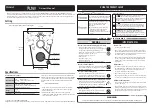
EtherCAT interface
Leuze electronic GmbH + Co. KG
AMS 338
i
53
TNT
35/7-2
4V
9
EtherCAT interface
9.1
General information on EtherCAT
EtherCAT is an Ethernet-based fieldbus initiated by the Beckhoff corporation. The EtherCAT
Technology Group (ETG) is the official standardization partner of the IEC working groups.
EtherCAT has been an IEC standard since 2005.
• IEC 61158: Protocols and services
• IEC 61784-2: Communication profiles for the specific device classes
All EtherCAT-specific communication mechanisms are described in detail in the standards
mentioned above. The technical description of the AMS 338
i
describes parts of the IEC stan
-
dard if this assists general understanding.
9.2
EtherCAT topology
EtherCAT permits a multitude of topologies such as line, tree, ring, star and combinations of
these. The bus or line structure known from the fieldbuses is thus also available for EtherCAT.
Telegrams are sent on a wire pair in the "processing direction" from the master to the slave.
The EtherCAT device processes the frames only in this direction and passes them on to the
subsequent device until the telegram has passed through all devices. The last device sends
the telegram back to the master on the second wire pair in the cable in the "forward direction".
Here, the EtherCAT always forms a logical ring structure regardless of the topology installed.
From an Ethernet point of view, an EtherCAT bus segment is nothing more than a single,
large Ethernet participant which sends and receives Ethernet telegrams. Within the "partic
-
ipant", however, there is a multitude of EtherCAT slaves rather than one single Ethernet
controller.
Figure 9.1: Topology example
















































